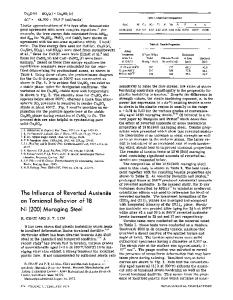Thermodynamic stability of binary oxides in contact with silicon
- PDF / 385,107 Bytes
- 20 Pages / 612 x 792 pts (letter) Page_size
- 2 Downloads / 296 Views
MATERIALS RESEARCH
Welcome
Comments
Help
Thermodynamic stability of binary oxides in contact with silicon K. J. Hubbarda) and D. G. Schlom Department of Materials Science and Engineering, The Pennsylvania State University, University Park, Pennsylvania 16802-5005. (Received 8 June 1995; accepted 26 April 1996)
Using tabulated thermodynamic data, a comprehensive investigation of the thermodynamic stability of binary oxides in contact with silicon at 1000 K was conducted. Reactions between silicon and each binary oxide at 1000 K, including those involving ternary phases, were considered. Sufficient data exist to conclude that all binary oxides except the following are thermodynamically unstable in contact with silicon at 1000 K: Li2 O, most of the alkaline earth oxides (BeO, MgO, CaO, and SrO), the column IIIB oxides (Sc2 O3 , Y2 O3 , and Re2 O3 , where Re is a rare earth), ThO2 , UO2 , ZrO2 , HfO2 , and Al2 O3 . Of these remaining oxides, sufficient data exist to conclude that BeO, MgO, and ZrO2 are thermodynamically stable in contact with silicon at 1000 K. Our results are consistent with reported investigations of silicon/binary oxide interfaces and identify candidate materials for future investigations.
I. INTRODUCTION
The fabrication of oxide thin-film microstructures on silicon substrates offers tremendous opportunities for the future of microelectronic devices. Such microstructures would allow oxide layers to be fully integrated with silicon circuitry and the broad variety of optical, electronic, and magnetic properties of oxides to be utilized onchip. If high dielectric constant (er ) oxides, ferroelectric oxides, high transition temperature (Tc ) superconducting oxides, or magnetic oxides could be combined with existing semiconductor technology, the materials properties available for use in microelectronics would be drastically enhanced, allowing improved functionality and performance to be realized. Unfortunately, direct growth of these oxides on silicon is frequently accompanied by extensive interdiffusion or chemical reactions that degrade the properties of the oxide, the underlying silicon, or both.1–8 Consequently, the focus of a great deal of materials research has been devoted to overcoming these obstacles through the identification of compatible buffer layers for use between silicon and the desired oxide layers.7–9 Several factors must be considered in selecting materials for use as buffer layers between silicon and a particular oxide: chemical reactions, interdiffusion, thermal expansion match, crystal structure, and lattice match are some of the most important.8–10 Extensive chemical reaction between the buffer layer material and silicon or between the buffer layer material and the overlying oxide can result in the formation of interfacial phases that often result in a loss of epitaxy. Interdiffusion a)
Present address: EPI, Chorus Corporation, St. Paul, Minnesota 55110. J. Mater. Res., Vol. 11, No. 11, Nov 1996
http://journals.cambridge.org
Downloaded: 14 May 2014
among silicon, the buf
Data Loading...










